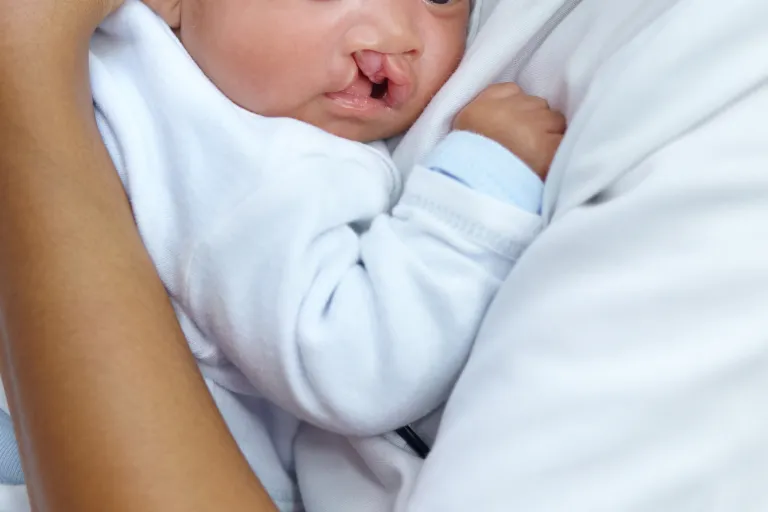Key Points
- Cleft lip and palate are among the most common birth-related facial differences worldwide.
- Early diagnosis supports better feeding, speech development, and long-term planning.
- Modern surgeries, orthodontics, feeding support, and speech therapies offer strong user outcomes.
- Multidisciplinary teams guide families from infancy through adolescence.
A Difference Seen Early—and Felt Deeply
For many families, the first glimpse of a cleft lip arrives unexpectedly during a routine prenatal scan. The image can spark worry—How will my baby eat? Will they speak clearly? What does the road ahead look like?—but the science behind cleft care has never been stronger. Children born with cleft lip or cleft palate today benefit from decades of refined surgical techniques, improved feeding tools, and coordinated long-term support.
Clefts are common, affecting roughly 1 in 700 births globally [1]. Yet despite how frequent they are, misunderstandings remain. This article offers a clear look at why clefts occur, how they’re diagnosed, and what modern therapies can achieve.
Why This Matters: The Hidden Challenges Behind a Visible Difference
Cleft lip and palate aren’t simply cosmetic differences. They influence how a child eats, breathes, hears, and develops early speech patterns. Families often face a mix of practical hurdles and emotional stress in the first weeks:
- Difficulty creating suction during feeding
- Milk passing into the nose
- Slower weight gain
- Speech problems as toddlers learn to talk
- Dental crowding or missing teeth
- Frequent ear infections caused by fluid buildup
Without early guidance, these challenges can feel overwhelming. With coordinated care, most children grow up healthy and confident, often requiring fewer therapies over time as techniques improve.
What Cleft Lip and Palate Look Like in Real Life
Cleft presentations vary widely. A baby may have a small notch in the lip—or a wider opening reaching the nostril. A cleft palate may be subtle or extend the length of the roof of the mouth. These variations influence feeding, breathing, and speech development in different ways.
Studies show that children with cleft palate are more likely to experience middle-ear fluid buildup, which can impact hearing and early language development if untreated [2]. These early experiences underscore why understanding the biology behind clefts is essential to creating a thoughtful, long-term care plan.
The Biology Behind Orofacial Clefts: How They Form Before Birth
The face forms early—between the 4th and 10th week of pregnancy—when tissues grow from each side and meet in the center. When these tissues do not fuse completely, a cleft lip, cleft palate, or both can occur.
Researchers have identified several contributing factors:
- Genetic influences, including mutations affecting craniofacial development [3]
- Environmental exposures, such as maternal smoking or certain medications [4]
- Nutritional factors, including low folic acid levels before and during pregnancy [5]
Importantly, most cases result from a complex mix of genetic and environmental factors—not something parents caused. Many occur without any known risk factor.
How Modern Medicine Detects Clefts: From Prenatal Imaging to Newborn Evaluations
Seeing the First Clues: Prenatal Diagnosis
Routine second-trimester ultrasounds detect most cleft lips, and newer high-resolution or 3D imaging tools can show the extent of the cleft with surprising clarity. Cleft palates are harder to see, but fetal MRI may help when ultrasound findings are unclear [6].
After Birth: Understanding the Full Picture
Once the baby arrives, a health professional assesses:
- Feeding ability
- Palate structure
- Breathing patterns
- Middle-ear function
- Growth and weight gain
This early evaluation guides therapy choices during the critical first months of life.
Today’s Leading Therapies: Modern Solutions That Support Growth and Development
Surgery That Supports Function and Form
Surgery remains the primary therapy for cleft lip and palate. Timing varies, but many families follow this general timeline:
- Cleft lip repair at 3–6 months
- Cleft palate repair at 9–18 months
Techniques like the Fisher anatomic subunit repair and Furlow palatoplasty focus on restoring muscles needed for speech, improving symmetry, and supporting long-term facial growth. Decades of refinement have created strong user outcomes, with many children achieving typical speech after repair [7].
Feeding Support That Makes the First Weeks Easier
Infants with cleft palate often need specialized bottles designed to compensate for low suction. Upright feeding, pacing breaks, and caregiver coaching help babies gain weight steadily.
Orthodontics and Early Dental Guidance
As the child grows, orthodontic care helps align teeth and guide jaw development. Some infants benefit from nasoalveolar molding (NAM)—a device that gently moves tissues into a more optimal position before lip repair.
Speech Support Throughout Childhood
Speech sessions help children learn correct sound production and strengthen oral muscles. Early therapy—ideally beginning before age 3—has been shown to reduce long-term speech differences [8].
Ear and Hearing Support
Because cleft palate affects the muscles that support the Eustachian tube, fluid buildup is common. Small ear tubes are often recommended to protect hearing and support speech development.
Why Cleft Teams Matter: The Power of Multidisciplinary Care
One of the most important advances in cleft care is the rise of multidisciplinary teams. Instead of navigating separate appointments with separate specialists, families work with a coordinated group that may include:
- Surgeons
- Orthodontists
- Speech therapists
- Audiologists
- Feeding specialists
- Social workers
Research shows that team-based care improves long-term speech, dental health, and user outcomes while reducing stress for families [2].
What Families Can Do Next
If your newborn has a cleft lip or palate, consider these early steps:
- Connect with a cleft team as soon as possible.
- Learn feeding strategies that support steady growth.
- Discuss timelines for surgeries and therapies.
- Seek community support, both in-person and online.
Understanding the path ahead—and having the right team—makes a tremendous difference.
Conclusion
Cleft lip and cleft palate may feel overwhelming at first, but today’s scientific insights, therapy options, and team-based approaches offer strong, supportive pathways forward. By understanding how clefts develop, how they’re diagnosed, and what modern therapies can achieve, families can navigate this journey with clarity and confidence.
Medical Disclaimer:
This article does not in any way constitute medical advice. Please seek consultation with a licensed medical professional before starting any therapy. This website may receive commissions from links or products mentioned in this article.
Subscribe for Free for more insightful health articles tailored to your needs.
Sources
- World Health Organization. (2023). Global prevalence of orofacial clefts. https://www.who.int
- American Cleft Palate-Craniofacial Association. (2022). Guidelines for cleft care. https://acpa-cpf.org
- Dixon, M. J., Marazita, M. L., Beaty, T. H., & Murray, J. C. (2011). Cleft lip and palate: Understanding genetic and environmental influences. Nature Reviews Genetics, 12(3).
- U.S. Centers for Disease Control and Prevention (CDC). (2022). Risk factors for orofacial clefts. https://www.cdc.gov
- Wilcox, A. J. et al. (2007). Maternal folate levels and risk of cleft lip and palate. BMJ, 334(7591).
- Johnson, D., & Dixon, M. (2018). Prenatal diagnosis of cleft lip and palate. Obstetrics & Gynecology Clinics.
- Shaw, W. C. (2010). Global surgical outcomes for cleft lip and palate repair. Plastic and Reconstructive Surgery.
- Peterson-Falzone, S., Hardin-Jones, M., & Karnell, M. (2010). Cleft Palate Speech. Elsevier.
Last Updated on November 26, 2025



